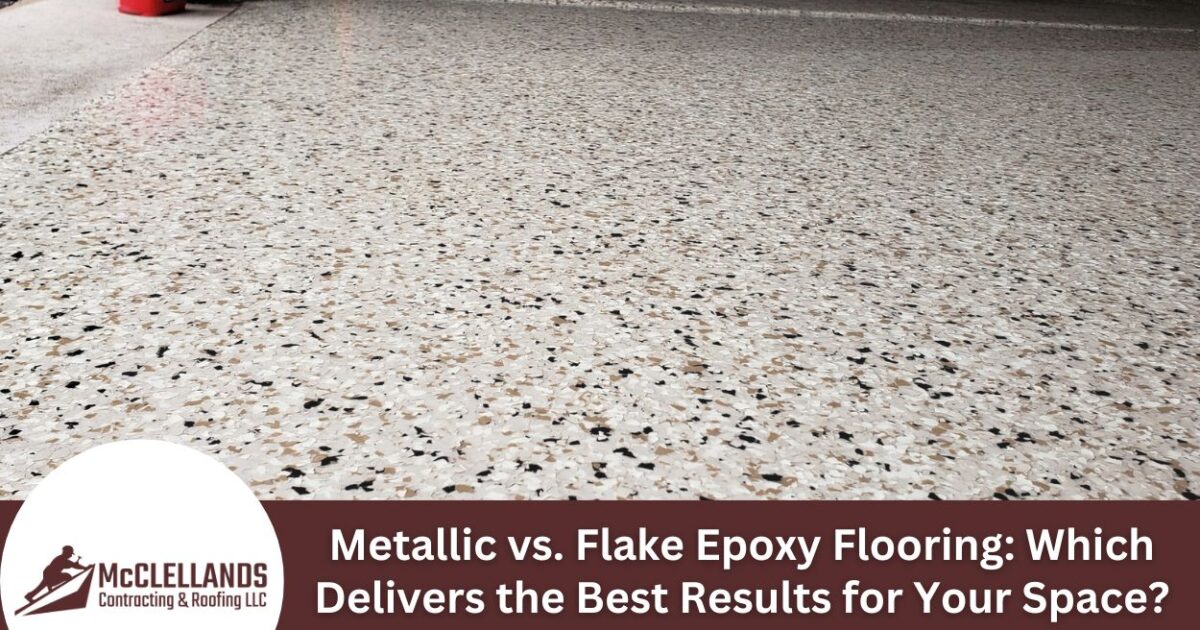Property owners seeking durable, attractive flooring solutions are increasingly turning to decorative concrete floor coatings over traditional options like plain concrete or basic paint. Two standout systems have emerged as top choices: metallic epoxy and flake epoxy flooring. Both epoxy floor coating options transform ordinary concrete surfaces into stunning, resilient floors that withstand heavy use with amazing visual appeal.
Metallic epoxy flooring creates dramatic, 3D effects with swirling patterns that mimic natural stone, water, or molten metal. This premium coating system uses specialized metallic pigments that shift and flow during application, resulting in unique designs that cannot be replicated. The finished surface offers a glossy, seamless appearance that reflects light beautifully.
Flake epoxy flooring takes a different approach, incorporating colored vinyl chips across a base coat. This system provides texture, slip resistance, and the ability to hide minor surface imperfections. This floor epoxy type also comes in various chip sizes and color combinations, from subtle speckled patterns to bold, multi-colored designs.
Understanding the benefits of both metallic and flake epoxy flooring helps determine which system best matches your durability requirements and aesthetic preferences for your concrete surface project.
Metallic vs. Flake Epoxy Flooring: Comparing Your Options
While metallic and flake floor coatings are both epoxy-based, they have numerous differences that impact their suitability for various projects. When making a final decision, consider these factors:
- Visual Impact and Design Flexibility
These epoxy floor coating options create unique finishes that appeal to different design preferences. Metallic epoxy flooring has the ability to produce stunning 3D effects that appear to flow and move across the surface. These swirling patterns create depth and movement that mimics natural elements like flowing water, molten lava, or polished stone. The metallic pigments interact with the epoxy base during application, forming patterns that shift and change as light moves across the surface throughout the day.
Flake epoxy flooring advantages center around versatility and customization options that suit both conservative and bold designs. The colored vinyl chips come in virtually unlimited combinations, allowing property owners to create subtle speckled effects or vibrant multi-colored statements. Small chips produce a refined, granite-like appearance, while larger flakes create more dramatic texture and visual interest. The application method evenly distributes the chips while providing slip resistance and concealing minor concrete imperfections.
Both floor epoxy types offer more design flexibility compared to traditional concrete treatments. Metallic systems excel in creating luxury, high-end appearances perfect for showrooms or entertainment spaces. Flake systems provide practical beauty that works well in garages, workshops, and commercial environments where looks and functionality matter equally.
- Durability and Performance Under Real-World Conditions
Long-term performance distinguishes quality epoxy floor coating options from inferior alternatives when subjected to daily wear and other stresses. Metallic epoxy flooring has exceptional durability through its thick film build and seamless surface that resists cracking and delamination. The absence of aggregate materials means no loose particles can separate from the coating over time. Traffic tolerance is excellent due to the uniform thickness and superior adhesion properties inherent in metallic formulations.
Flake epoxy flooring comes with enhanced impact resistance provided by the vinyl chips. The flakes create a textured surface that distributes point loads across a wider area, reducing the likelihood of damage from dropped tools or heavy equipment. This makes flake epoxy flooring particularly suitable for garage floors where mechanical equipment and automotive maintenance occur regularly.
Chemical resistance varies between these decorative concrete floor coatings. Metallic epoxy flooring benefits include seamless surfaces that prevent chemical penetration and make thorough cleaning straightforward. The smooth finish resists staining and allows spills to be wiped away easily. Flake epoxy systems easily handle harsh cleaning products, though the textured surface may require more aggressive cleaning methods to remove embedded contaminants. Both systems maintain their integrity when exposed to automotive fluids, household chemicals, and commercial cleaning solutions, ensuring long-term performance in most environments.
- Installation Requirements and Process Differences
Before installation begins, surface preparation is needed for these decorative concrete floor coatings. Metallic epoxy flooring requires pristine substrate conditions since any surface imperfections become magnified through the glossy, reflective finish. The concrete must have a consistent profile without gouges or uneven areas that would disrupt the flowing metallic patterns. Professional diamond grinding equipment creates the proper surface texture for optimal adhesion while eliminating any existing coatings or contaminants completely.
Flake epoxy flooring advantages include greater tolerance for minor surface irregularities due to the textured finish that helps conceal small defects. While proper surface preparation remains essential for adhesion, the chips can mask slight variations in the concrete substrate. This makes flake systems more forgiving during installation and potentially suitable for surfaces that might not meet the stringent requirements of metallic applications.
Application techniques differ substantially between these floor epoxy types, affecting both skill requirements and installation timelines. Metallic epoxy requires advanced application expertise to manipulate the flowing pigments and create desired patterns before the material begins to cure. Installers must work quickly and possess artistic skills to achieve consistent results across large areas. On the other hand, flake epoxy applications need close attention to even chip dispersion across the floor.
Timeline considerations for epoxy floor coating options impact project scheduling and space availability. Metallic systems typically require longer cure times between coats and additional drying periods for topcoat applications. Flake epoxy installations often proceed more rapidly, with shorter intervals between application phases, allowing spaces to return to normal use sooner than metallic alternatives in most floor coating projects.
- Maintenance and Long-Term Care
These decorative concrete floor coatings require different cleaning approaches based on their surface characteristics and maintenance requirements. Metallic epoxy flooring has simple cleaning protocols due to its seamless, non-porous surface that resists dirt accumulation and staining. Regular sweeping or dust mopping removes loose debris, while damp mopping with neutral pH cleaners maintains the glossy appearance without damaging the metallic finish. The smooth surface allows spills to be wiped away immediately before they cause permanent staining.
Flake epoxy flooring generally withstands more aggressive cleaning methods when necessary. The textured surface may trap dirt and debris more readily than smooth metallic surfaces, requiring slightly more intensive cleaning routines. Scrub brushes or mechanical floor scrubbers effectively remove embedded contaminants from the textured surface without damaging the chip aggregate. Standard floor cleaners work effectively on both epoxy types, while avoiding harsh acids or solvents preserves the flooring over time.
Repair procedures for wear patterns or surface damage differ significantly between these epoxy floor coating options. Metallic epoxy systems require professional restoration since matching the original flowing patterns proves nearly impossible for localized repairs. Small scratches can often be polished out, but larger damage typically necessitates complete section refinishing to maintain aesthetic continuity.
Flake epoxy surfaces accommodate spot repairs more easily due to their random chip distribution patterns. Minor chips or scratches can be addressed by adding matching flake material and a clear topcoat that does not create obvious patch marks.
- Environmental and Application Limitations
Some characteristics make certain epoxy floor coating options more suitable for specific environments. High-traffic commercial settings with constant foot traffic, heavy equipment or inventory, and frequent cleaning tend to favor flake epoxy flooring for its enhanced slip resistance and impact tolerance. The textured surface provides superior traction when wet while distributing concentrated weight effectively. Retail spaces, warehouses, and manufacturing facilities often benefit from the durability and maintenance-friendly properties of flake systems.
Residential applications often showcase metallic epoxy flooring in spaces with limited foot traffic. Basement recreation rooms, home gyms, and converted garages create ideal environments for metallic systems to display their artistic qualities without excessive wear concerns. The seamless, reflective surface enhances lighting while creating luxurious appearances that complement modern home designs.
Climate conditions, including temperature fluctuations, UV exposure, and humidity levels, significantly impact the long-term performance of both floor epoxy types. Extreme temperature variations can stress rigid coating systems, though both metallic and flake epoxy formulations demonstrate excellent thermal stability within normal indoor ranges. Areas subject to freeze-thaw cycles require proper substrate preparation and high-quality epoxy formulations to prevent delamination.
UV stability is crucial for decorative concrete floor coatings exposed to direct sunlight through windows or skylights, though most epoxy flooring incorporates UV-resistant topcoats that prevent yellowing and maintain color integrity over time. Moisture resistance is also excellent in both applications, with proper installation creating impermeable barriers that protect underlying concrete from water damage while maintaining its decorative appearance in various environmental conditions.
- Long-term Value and Return on Investment
Understanding the financial implications of epoxy floor coating options requires careful analysis of both upfront costs and long-term value considerations. The initial investment includes material quantities, surface preparation requirements, and labor that all influence project totals. Metallic epoxy flooring generally comes with higher costs due to the specialized pigments and skilled professionals needed for application.
Comparatively, the vinyl chips in flake options add minimal cost while providing substantial visual impact and performance benefits. Flake systems typically require less specialized equipment and can accommodate installers with broader skill ranges, potentially reducing labor expenses.
There are also noticeable differences in long-term ownership costs between these systems.
Metallic epoxy installations often increase property values substantially due to their premium appearance and luxury market appeal. The seamless, artistic surfaces create distinctive features that differentiate properties in competitive markets. However, repair complexities and refinishing requirements may increase maintenance expenses over time.
Flake epoxy systems deliver excellent value through extended service lives and reduced maintenance demands. The durable chip aggregate surface withstands heavy use while accommodating spot repairs without professional restoration requirements. Total ownership costs typically favor flake systems in high-traffic environments where durability outweighs aesthetic considerations, making these floors practical investments for both residential and commercial settings.
Choose the Best Epoxy Flooring with McClellands Contracting and Roofing, LLC
Deciding between metallic and flake epoxy flooring systems can significantly impact the functionality and style of your space. Each option has benefits, whether you seek the stunning, deep look of metallic epoxy or the robust, customizable appeal of flake flooring. However, the best results come from professional installation.
At McClellands Contracting and Roofing, LLC, we specialize in high-quality epoxy floor coatings that are tailored to meet your needs. Our expert team ensures that each installation is performed meticulously, promising durability and a spectacular finish regardless of the system you choose. Don’t compromise on the quality and appearance of your flooring.
Ready to transform your space with the best epoxy flooring? Call us at (412) 353-5660 and let McClellands Contracting and Roofing, LLC help you choose the best option for your property.

